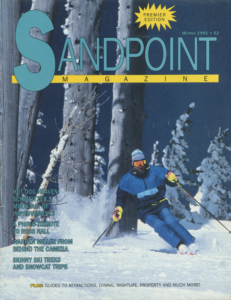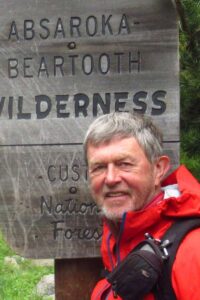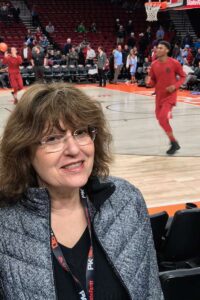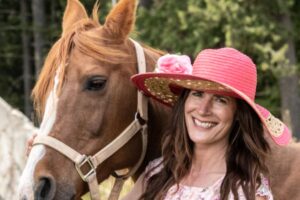Sandpoint Magazine Turns … 30!
From the Winter 2021 Issue
Original contributors look back on 30 years of stories

This edition of Sandpoint Magazine marks the 30th year since the inaugural Winter 1991 edition was published in November 1990. It was a first for Sandpoint: A color glossy magazine, striving to produce excellent journalism with the singular mission “to help you get more out of being in Sandpoint,” as we wrote then.

A lot has changed since 1990—for both our town and this magazine—but somewhat amazingly, a small cadre of the original contributors who helped give birth to Sandpoint Magazine still call this town home. And for our 30th birthday, we invited four of the writers who contributed to Sandpoint Magazine in its first year to tell us about some of their favorite stories from the decades. After all, who could be better suited to spill the beans on Sandpoint Magazine itself?
Quiz: What’s Changed in 30 Years? We cooked up three fun quizzes about what’s changed ’round here these since the first Sandpoint Magazine. There are some clues in this story. Read on below, then take the first quiz»
Original contributors joining publisher Chris Bessler for a roundtable interview via Zoom were Sandy Compton, our first columnist as well as the inaugural issue’s ad sales director; Susan Drinkard, past and sometimes present Daily Bee journalist; Billie Jean Gerke, the magazine’s first editorial staffer and subsequently its editor through 2016; and David Gunter, freelancer, musician and man of assorted talents. Following are outtakes from the conversation.
SANDY COMPTON

Chris Bessler: Sandy Compton, you were in that very first issue, with a couple pieces. And you’re still writing. What are some of the stories that stick out for you?
Sandy Compton: It’s funny. Between 107 stories for you and writing 250 columns for the River Journal, they all start running together. But the first one I’d have a little comment on is “All Ahead Slow,” (Winter 1992) about the photographer Ross Hall. That one has produced a lot of positive comments for me. His son Dann Hall is still using it to put on the back of the pictures he sells out of the Hallans Gallery. I also wrote a piece about Dann’s mom Hazel Hall later on (“Hazel Hall, that’s all,” Winter 2010). Ross and Hazel were both such extraordinary people.
CB: I well remember the piece on Hazel. You wrote that you had a crush on an older woman.
SC: Oh man. I saw a picture of Hazel as a young woman … well we won’t go there.
David Gunter: Don’t start on the early Hazel Hall pictures. What a cutie.
SC: Actually I saw a picture of Hazel in Dann’s studio when he had that little studio over there by the Hydra. He had this picture of this really beautiful young woman hanging on the wall, and I said, “Dann, who’s the babe?” And he said, “That’s my mom.” I went “oops.” (laughs)
Another story was “Who We Are,” (Winter 1996) the original story in response to all the publicity Sandpoint was getting because Mark Fuhrman moved here.
CB: That was an epic piece, and I think it was an important one for us at that time because Sandpoint was this focal point of national attention when Mark Fuhrman moved to town after the O.J. Simpson trial. He was the detective in that case. And it also focused people back on the fact that we had Ruby Ridge happen a few years prior to that and the Aryan Nations was around. North Idaho was getting painted as a haven for racists. And your story was a response to that.
SC: The history pieces are memorable. The “100 Years of Sandpoint” (Winter 2000). The stories about Schweitzer, particularly Schweitzer history. The “Stories from the Ski Patrol” story I did in 2007 (Winter 2007) was a lot of fun for me and also it was great to get to know the ski patrollers better, particularly John Pucci. He is an incredible guy. And then the story I wrote about Jack Fowler’s involvement in Schweitzer’s launch (“A good idea that got out of hand,” Winter 2008).
DAVID GUNTER
CB: Okay, now Mr. Gunter: Stories that stuck out for you.

DG: An area I sort of got tapped for was the Q&A format, primarily of people in the arts, which was always fun. The first one I did was initially very confrontational, and that was with Festival at Sandpoint musical director Gunther Schuller (Feature Interview, Summer 1991). I got on the phone with Gunther and the first thing he said was, “I don’t know why I’m even talking to you, you people who are fans of Madonna and don’t know anything about classical music.” And he just went into this full-blown rant about what an obvious musical illiterate I must be. Listening to him I thought, oh, this guy does the thing where he pushes and acts like a complete ass. And if you don’t push back he’ll savage you, and if you push back he thinks you’re great. So I think I just listened for about 30 seconds and said, “Hold it, sport,” which stopped him up short. I said, first of all, I think Madonna is a poseur and her music is terrible. Secondly, my father was a concert violinist and I’ve listened to classical music all my life. And thirdly, I’m a big fan of your Third Wave Movement, that confluence of contemporary jazz and classical music. So then we were off to the races. But it was one of those moments it could have gone off the rails and been no interview at all. So just being able to salvage that one was fun.
SC: So David, how did you make those three comebacks up just like that?
DG: Sandy, you know, I’ve always been good at landing on my feet. And I love Madonna. And my dad was a VW mechanic. (laughter)
CB: Hey, there’s a lot to be said for VW mechanics.
DG: Absolutely. And it turned out to be a fun interview. I think once you get anyone talking about themselves, you can get them telling anecdotes. You guys all know. Short questions that evoke situational memories are golden. The interview with guitarist Leon Atkinson (Feature Interview, Winter 2010) was fun in that way, although it was tough to lure Leon away from his curriculum vitae because he wanted to talk about all these things that he was looking, understandably so, to get mentioned. And I was looking for a good conversation. And I think we both got something out of that. It turned out to be a pretty strong back and forth. Although I still really don’t believe he met the Beatles. But that’s okay because it’s a good story.
And then there was “Is Sandpoint An Arts Community … Really” (Winter 2009) that I enjoyed because that’s a term that had been bandied about Sandpoint forever. It was fun to kind of pin that down because, first, what does that even mean? And secondly, do we clear the bar? It’s fun to look back at all those people who were involved in what was a really robust art scene then, and it’s kind of weirdly moribund now. But we have lots of bars with music, so I guess we’ve got something.
Billie Jean Gerke: (holding up the Winter 1991 magazine): Sandy’s very first column in the very first issue.
CB: “Two Trips Home,” yeah.
BJG: (reading) “The first time I saw Sandpoint I was awed. But everything is awesome to someone six months old … we have mouths that hang open and drool a lot at that age.” (laughs)
CB: Some things never change.
DG: Yeah, he’s still drooling.
CB: He’s coming full circle though.
SC: Right. That’s right
SUSAN DRINKARD

CB: Okay. Next, Susan, you’re up.
Susan Drinkard: My stories are so inappropriate… But the most memorable would have to be the Kienholzes.
CB: The interview with the artists Ed and Nancy Kienholz (Feature Interview, Winter 1992). I’ve heard this one before but please, go on.
SD: You remember, I told you. Well, when I got to their house Nancy was taking a shower and Ed had just come from a shower and he just had on these little shorts. So I started asking him questions and he took his weenie out and he just thought it was hilarious. Because of the way I reacted, trying to ignore it. I couldn’t believe it, you know, that a human would do that. Kienholz, he was a rascal, he was such a rapscallion. So he just showed it to me and then he giggled and then his wife came down and of course it was gone. And I kept thinking, did that really happen? Maybe it didn’t happen? But it did.
SC: This is going in the magazine, right Bessler?
CB: Geez. I don’t know.
SD: You know he was so into shock value. He loved that. And it was reflected in his art, you know. But it was also just such a memorable experience because they let me see all the work they had in the old school in Hope there. One piece, I’ll never forget it. They had made a bedroom, an entire bedroom, bed, dresser, the whole shebang, out of adding machine tape that had been used. Adding machine tape. It was just amazing and interesting. That was memorable. Plus the fame factor. You know, he’s in encyclopedias.
CB: They were very influential artists internationally, although most people here had no clue, basically.
DG: And now he’s part of the #MeToo movement.
CB: Yeah, you just made him part of the #MeToo movement Susan.
SC: Way to go.
CB: Way to go. Way to ruin a legacy.
SD: No I really respected those guys … (sighs). He just wanted to throw me.
CB: Okay. Moving on.
SD: Another one was, the musician Charley Packard… I got to interview him in 2014 (Feature Interview, Summer 2014). I just really liked his music. I think some of his songs, like that song “Gimme an Ol’ Gal,” somebody should have picked that up like Willie Nelson or somebody of that caliber. Charley didn’t live a lot longer after that. He was very sick when I interviewed him. I was just happy to have that opportunity.
The interview that impressed me the most was the one with the author (Sandpoint native and Pulitzer Prize winner) Marilynne Robinson (Feature Interview, Winter 2006). I had just read her book “Gilead” while I was in Costa Rica, where I had no distractions, no TV, and I was in the jungle so I read every sentence carefully. I just thought she was the best writer in the world. And I had the ability to focus because it’s not a very easy book. Then I just called her and she answered her phone. I thought Marilynne would be hard to reach. But I just called her at home, and she answered. She was studying Calvinist theology… for fun.
CHRIS BESSLER
CB: I’m saving Billie Jean for last so I’m going to mention a few stories I did that were memorable. The very first issue, the “Mountain of Change” (Winter 1991) was about Schweitzer just after they had done the big upgrades there and built the Green Gables Lodge, and they’d torn down the old original Bierstube—actually, they burned it.
SC: They burned it. They tried to tear it down and it wouldn’t come down so they burned it.
CB: And people in town were kind of shocked by that. But that was really the transformation of Schweitzer and it’s so unfortunate the Brown family ended up losing the property. That one sticks out because I was trying to imagine how the mountain would change after they put in the first high-speed quad, and how that would change skiing the mountain. And now, Schweitzer just put in some new chairlifts on the backside and Mr. Compton is writing in this issue about how it’s changed skiing on the mountain.
Another one I wrote was “Back to the Continental Mine” (Summer 1994). That was just kind of fun, because the first book our company published was “The Klockmann Diary,” by A.K. Klockmann, who founded the Continental Mine up in the Selkirks. For the story I was retracing his steps by the route he first went up there in the 1890s, by way of Priest River and Priest Lake. I canoed up the Upper Priest Lake and then I hiked up the Cedar Creek drainage and ran into bears… anyway that one sticks out.
Finally, the interview with the Soviet spy and bank robber Christopher Boyce (Feature Interview, Winter 2014) was memorable because I’m sure I probably had a beer with Boyce when I lived in Bonners Ferry in the 1970s and he was hiding out from the FBI up there. I was working at the Bonners Ferry Herald and my boss and I would go drink at the Mint Club after deadline, and Boyce said he would drink at the Mint Club, and who knows? But it’s interesting, we chased him, Billie Jean chased him, trying to get him for an interview for years when he was still in prison and when he was released to the halfway house. We finally got the interview after he was released and had written a book.
And that brings us to Billie Jean, with the biggest list of stories. Billie, give us a few of your most memorable ones.
BILLIE JEAN GERKE

BJG: I told you I’m not a good speaker and I wouldn’t have anything good to say.
SC: That was perfect. Thank you. Thank you very much.
SD: You’re so succinct.
BJG: Okay, my first cover story was the Summer 1994 issue, in which I wrote the “Timber Town” cover story. And of course, as we all know, I married a local logger.
CB: That’s really getting into your work right there, Billie Jean.
BJG: I wrote the story two years after we got married. So that was kind of cool, talking to the old-time loggers. So many of the people I talked to for that story, of course, have passed on. It was just really great looking into the history and seeing all these great historic photographs, many of them by Ross Hall. Also, just having that connection with my own family being a family with multiple generations logging.
One of the best things about my job was getting to meet people that I otherwise normally would not have a chance to meet. My first feature interview I believe was the humorist Patrick McManus (Feature Interview, Summer 1995). So that was really cool to meet him. I went out to his home. They had a second home on the Clark Fork River at the time.
I believe the second feature interview I got to do was with the inventor, Dr. Forrest Bird (Feature Interview, Winter 1995) and so that was terribly fascinating, getting to interview him and learn what a tremendous life he had. Getting a tour through his home and his medical research building and even getting to see how they grew all their own food. He opened up this floor in this back outbuilding to go down and see his massive pantry of canned goods… so it was so cool to see the way that he lived and the work that he did and think about all the lives that he saved. And here it was, out in the boondocks, this high technology manufacturing facility, way, way, way out of town.
Another was the interview with the football great (and SHS grad), Jerry Kramer (Feature Interview, Summer 1998). What an honor it was to meet him and spend the day with him in Boise. Of course, back then one of the questions had to do with the Pro Football Hall of Fame and why he wasn’t in it. It took another 20-some years for that to be resolved. We enjoyed talking about our common connection to his high school teammate, who was my father-in-law, Leonard Plaster, and about Wisconsin, my native state.
It was always great. You know I grew up here, partly; five years of my schooling was in Sandpoint. I went back to my home state, Wisconsin, to study journalism. I never imagined that I could have a career in my hometown. I moved back because I wanted to be back in the Northwest but I thought I would live in Spokane. But after living here a few months I realized, I did not move back to the Northwest to live in Spokane, I came back to live in Sandpoint. So I believe it was January 2, I marched downtown and I went into the Sandpoint Unlimited office and I talked to Debbie Ferguson and told her, here I am, I have a journalism degree, I want to stay in my hometown, what’s here for me? And she pointed across to the Farmin Building and she said, you should go talk to Chris Bessler, he just started a publishing company and just published Sandpoint Magazine. So I went straight from the Sandpoint Unlimited office and went upstairs in the Farmin Building and walked in with my little portfolio.
CB: Yes, you looked very businesslike. I remember that.
BJG: I had heels on in the winter, and my dress pants. And I was 23 years old. They were in this little one-room office, just him and Sandy Compton. Chris was like, I’m really busy, you’re going to have to make an appointment and come back. (laughs)
SC: He always says that and then he talks to you.
CB: All the big corporate guys are going to say that Billie Jean, come on.
BJG: I was just always always so grateful to be able to work in my chosen career in my hometown. I used to tell people, “I have the best job in Sandpoint.” And I meant it. I had the best job in Sandpoint. It was so fun. And it was a lot of hard work too, of course. Just being able to meet people I had never met before and to have a pulse on what was happening in Sandpoint…
CB: And that’s pretty good for someone who can’t speak.
Stories mentioned by the writers are listed at Memorable Stories»
And don’t forget our What’s Changed in 30 Years? contest. Go take the quiz»




Leave a comment